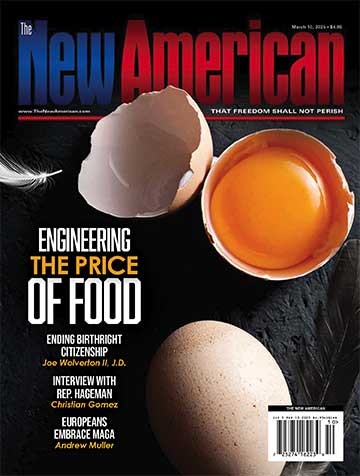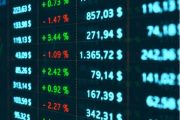
With the stock market’s huge losses in the past week — the largest decline since February — some economists blamed President Trump’s trade conflict with China. Trump, however, pointed to the Federal Reserve System’s recent decisions to raise interest rates as the more likely culprit.
“That wasn’t it,” Trump said this week in response to the China theory for the market drop. “The problem I have is with the Fed. The Fed is going wild. They’re raising interest rates and it’s ridiculous.” Trump added, “The Fed is going loco.”
Trump said again in another interview, “I think the Fed is uh … making a mistake. They’re so tight. I think the Fed has gone crazy.”
What precipitated Trump’s remarks was that the Federal Reserve — America’s central bank — has increased interest rates three times just this year. Of course, when interest rates go up, the cost of borrowing money goes up for both businesses and consumers, making more expensive purchases less likely, thus slowing down the economy, which has otherwise been booming during Trump’s presidency.
It would not be surprising if Trump’s suspicions that the Fed is deliberately trying to hurt him politically by putting the brakes to the economy turn out to be valid. But the larger question than how the Fed actions are affecting Trump politically is should this private monopoly have this kind of power over interest rates in the first place? And where is the Federal Reserve mentioned in the Constitution? (It is’nt).
It is indisputable that the Federal Reserve could, if it so chose, bring the American economy to its knees by drastically increasing interest rates. When asked if he is considering firing the chairman of the Fed, Jerome Powell, whom Trump appointed, Trump bluntly answered, “I’m not going to fire him.”
The truth is that President Trump is not allowed, under the law, to fire Powell — except for cause. In other words, the only time Trump or any other president can realistically remove a Fed chairman is at the end of the chairman’s term of office. Even White House economic adviser Larry Kudlow was quick to weigh in on Thursday: “We know the Fed is independent. The president is not dictating policy to the Fed. He didn’t say anything remotely like that.”
In fact, Kudlow seemed to support the Fed’s actions, arguing that it was managing “the transition from ultra, ultra easy money … to something more normal.”
Powell was even more blunt, saying the Fed pays no attention to politics, adding, “This is just who we are and I think who we will always be, which is, we’re a group who — we’re quite removed from the political process. And we just try to do the right thing for the medium and longer term for the country.”
There are multiple ways that the Federal Reserve can manipulate the economy through interest rates. One way is the “discount rate” that the Fed charges member banks. The discount rate is the rate of interest charged to a lending institution that borrows money from the Fed. The higher the discount rate, the more expensive it is for the bank to borrow, and therefore, the higher the rate will be when the bank loans money to a business or to an individual to make a larger purchase such as a car or a house. The lower the discount rate, the less expensive it is for the bank to borrow, and therefore, the lower the rate will be when the bank loans out money for major purchases.
After the financial meltdown of 2008, the policy of the Federal Reserve was to keep interest rates low to spur economic activity and revive the general economy. While such low interest rates do increase the purchase of homes and the like, it also causes the prices for these products to go up. Low interest rates are quite popular with home-buyers, for example, but they discourage saving — creating a hardship on those on fixed incomes who were counting on living on these savings in retirement.
The reality is that under the free market, interest rates would provide a natural “cooling off” of the economy. As there is a bigger demand for money at lower interest rates, the rates, under the law of supply and demand, would begin to rise. As the rates rose, there would be a drop-off in demand for loans. This would then cause more saving to take place, which would put more money in the bank. This increased supply of money would then lead to a drop in interest rates. And so on.
In other words, if there were no central bank dictating interest rates, the free enterprise system would regulate interest rates and determine the amount of money in the economy.
While some argue that a central bank — in America it is called the Federal Reserve System — is needed to avoid the twin evils of inflation and depression, the hard reality is that the greatest economic collapse in U.S. history took place in August of 1929, nearly 16 years after the Fed was created by an act of Congress on December 23, 1913. There is nothing in the Constitution authorizing Congress to create a money monopoly, yet since its inception we have seen severe economic downturns in 1920, 1929, and 2008, along with several other recessions. The value of America’s money has been greatly diminished since the creation of the Fed. Since 1914, when the Fed began operations, the value of the dollar has declined to the point that it is worth less today than what nickel was worth back then.
Yet, no one can overturn the policy of the Federal Reserve — not the president and not the Congress. One can argue that interest rates need to be raised, but that could be done through the free market.
As mentioned above, the reality is that if the Fed’s leadership so desired, they could bring down the American economy via the manipulation of interest rates. Or they could touch off spiraling prices through inflationary policies.
Americans need to ask a serious question: Why should a private monopoly, uncontrolled by our elected representatives at each end of Pennsylvania Avenue, have that kind of power?
Photo of Federal Reserve headquarters: AgnosticPreachersKid via WikiMedia Commons





